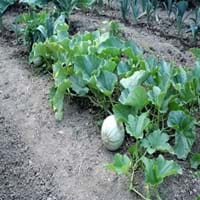Life Span
Perennial
Annual
Origin
Japan
Hybrid origin, Africa
Types
Not Available
C melo subsp melo
Habitat
Lawn, shaded fields, Shaded sites
gardens, Temperate Regions, Terrestrial
USDA Hardiness Zone
5-10
Not Available
Sunset Zone
3a, 3b, 4, 5, 6, 7, 8, 9, 14, 15, 16, 17, 18, 19, 20, 21, 22, 23, 24
2a, 2b, 3a, 3b, 4, 5, 6, 7, 8, 9, 10, 11, 12, 13, 14, 15, 16, 17, 18, 19, 20, 21, 22, 23, 24
Habit
Clump-Forming
Vining/Climbing
Flower Color Modifier
Bicolor
Bicolor
Fruit Color
Brown
White, Yellow, Light Yellow, Gold, Tan, Sandy Brown
Leaf Color in Spring
Dark Green, Gold
Green, Light Green
Leaf Color in Summer
Dark Green, Gold
Green, Light Green
Leaf Color in Fall
Dark Green, Gold
Green, Light Green
Leaf Color in Winter
Dark Green, Gold
Light Green
Plant Season
Spring, Summer, Fall, Winter
Summer, Fall
Sunlight
Partial shade, Full Shade
Full Sun
Growth Rate
Medium
Very Fast
Type of Soil
Clay, Loam, Sand
Loam
The pH of Soil
Acidic, Neutral
Neutral
Soil Drainage
Well drained
Well drained
Bloom Time
Late Spring
Indeterminate
Tolerances
Drought
Drought
Where to Plant?
Ground, Pot
Container, Ground
How to Plant?
Rooted stem cutting, stem tip cuttings
Seedlings, Transplanting
Plant Maintenance
Medium
Medium
Watering Requirements
Needs more water during establishment, Water Deeply, Water in morning to avoid prompting diseases, Water in the early morning hours
Do Not over Water, Keep the ground moist but not water-logged, Never Over-water, Requires a lot of watering, Requires regular watering, Requires watering in the growing season, Water Deeply
In Summer
Lots of watering
Lots of watering
In Spring
Moderate
Moderate
In Winter
Average Water
Average Water
Soil pH
Acidic, Neutral
Neutral
Soil Type
Clay, Loam, Sand
Loam
Soil Drainage Capacity
Well drained
Well drained
Sun Exposure
Partial shade, Full Shade
Full Sun
Pruning
Prune to control growth
Remove Vines
Fertilizers
All-Purpose Liquid Fertilizer, Apply N-P-K, Less fertilizing
All-Purpose Liquid Fertilizer
Pests and Diseases
Disease free, Insects, Red blotch
Red blotch
Plant Tolerance
Drought, Rocky Soil, Shade areas, Variety of soil types, Wet Site
Drought
Flowers
Insignificant
Showy
Flower Petal Number
Single
Single
Foliage Texture
Fine
Coarse
Foliage Sheen
Glossy
Matte
Attracts
Aphids, Bugs, Mealybugs, Scale Insects
Not Available
Allergy
Not Available
Abdominal pain, breathing problems, Diarrhea, Dizziness, Nausea, Vomiting
Aesthetic Uses
Beautification, Borders, Ground Cover, Landscape Designing
Not Used For Aesthetic Purpose
Beauty Benefits
Not Available
Not Available
Environmental Uses
Air purification
Air purification
Medicinal Uses
Not Available
anti-cancer, Antioxidants, Cardiovascular problems, Combats Stress, Eye Problems, Immunity, Insomnia
Part of Plant Used
Leaves
Fruits
Other Uses
Not Available
Economic Purpose, Employed in herbal medicine, Used As Food
Used As Indoor Plant
Yes
No
Used As Outdoor Plant
Yes
Yes
Garden Design
Container, Edging, Groundcover, Mixed Border, Rock Garden / Wall
Edible, Fruit / Fruit Tree, Herb / Vegetable, Vine
Botanical Name
CAREX hachijoensis 'Evergold'
CUCUMIS melo
Common Name
Carex oshimensis
Carex morrowii
Cantaloupe, Casaba Melon, Honey Dew, Melon, Muskmelon
In Hindi
Japanese Sedge
खरबूजा
In German
japanische Segge
Cantaloup Melone
In French
Japanese carex
Cantaloup
In Spanish
juncia japonesa
Cantalupo
In Greek
japanische Segge
Πεπονάκι
In Portuguese
Sedge japonês
Cantalupo
In Polish
japoński turzyca
Kantalupa
In Latin
Sedge Italica
cantaloupe
Phylum
Tracheophyta
Tracheophyta
Class
Magnoliopsida
Magnoliopsida
Order
Poales
Cucurbitales
Family
Cyperaceae
Cucurbitaceae
Clade
Angiosperms, Commelinids, Monocots
Angiosperms, Eudicots, Rosids
Tribe
Not Available
Melothrieae
Subfamily
Not Available
Cucurbitoideae
Number of Species
Not Available
Season and Care of Japanese Sedge and Cantaloupe
Season and care of Japanese Sedge and Cantaloupe is important to know. While considering everything about Japanese Sedge and Cantaloupe Care, growing season is an essential factor. Japanese Sedge season is Spring, Summer, Fall and Winter and Cantaloupe season is Spring, Summer, Fall and Winter. The type of soil for Japanese Sedge is Clay, Loam, Sand and for Cantaloupe is Loam while the PH of soil for Japanese Sedge is Acidic, Neutral and for Cantaloupe is Neutral.
Japanese Sedge and Cantaloupe Physical Information
Japanese Sedge and Cantaloupe physical information is very important for comparison. Japanese Sedge height is 20.30 cm and width 30.50 cm whereas Cantaloupe height is 20.30 cm and width 150.00 cm. The color specification of Japanese Sedge and Cantaloupe are as follows:
Japanese Sedge flower color: Tan
Japanese Sedge leaf color: Dark Green and Gold
Cantaloupe flower color: Yellow
- Cantaloupe leaf color: Green and Light Green
Care of Japanese Sedge and Cantaloupe
Care of Japanese Sedge and Cantaloupe include pruning, fertilizers, watering etc. Japanese Sedge pruning is done Prune to control growth and Cantaloupe pruning is done Remove Vines. In summer Japanese Sedge needs Lots of watering and in winter, it needs Average Water. Whereas, in summer Cantaloupe needs Lots of watering and in winter, it needs Average Water.





